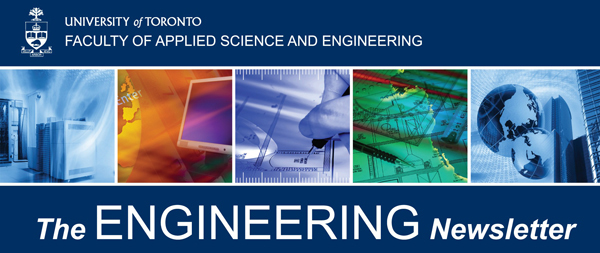 |
|---|
What's New?
Engineering Graduate Student Profiles
Graduate research and innovation in our Faculty thrives because of the dedication of our hard-working graduate students. Meet a selection of some our talented students led by devoted professors.
- David Caesar (CIV)
- Pamela Chan (MIE)
- Flor Yunuén “June” García Becerra (ChemE, Enviro)
- April Khademi (ECE)
- Maygan McGuire (ChemE)
- Todd Reichert (UTIAS)
- Mitren Sukhram (MSE)
- Kyle Vernest (IBBME, Clinical)
- Lorna Wong (MIE)
BA, University of Toronto, 1995
BArch, University of Toronto, 2002
MEng, University of Toronto, 2004
PhD Candidate, University of Toronto
Affiliations
- 20 years racing sailboats, including four years on the Canadian National Sailing team in the Star Class
- Represented Canada in eight sailing World Championships, won two North American Championships, seven National Championships and seven Provincial or State Championships in various classes
Describe your research.
I returned to U of T to pursue a PhD under the supervision of Professor Kim Pressnail (CIV). At the moment, I am concentrating on course work and teaching; however, as the program progresses, I will focus my research in low-energy housing, sound building science details, and passive and semi-passive heating and ventilation systems.
Why did you choose U of T for your Engineering graduate studies?
I completed a Bachelor of Arts degree in American studies and English Literature at U of T and wondered what to do with the future. I enrolled in the U of T Architecture program, which is where I discovered the subject of Building Science taught by Civil Engineering Professors Kim Pressnail and Jon Tumusk. After finishing Architecture, I completed a Master of Engineering in Building Science. I chose U of T because of the quality and diversity of the teaching staff, and because of the range of courses available to graduate students both within Civil and in other departments.
BASc, University of Toronto, 2006
MASc Candidate, University of Toronto
Honours and Awards
- Funded by the Bell University Labs Scholarships
- Barbara and Frank Milligan Fellowship
Affiliations
- Works with the Scarborough Hospital in partnership with Canada Health Infoway on the Enhancing Emergency Services Project where they have integrated a decision support triage system and multilingual patient-centered kiosks to improve healthcare accessibility, quality and productivity
Describe your research.
My current research involves understanding and analyzing how systemic factors impact wait times in the Emergency Department. Academic Supervisor: Professor Michael W. Carter (IBBME).
Why did you choose U of T for your Engineering graduate studies?
U of T is one of the leading institutions for graduate research. More specifically, U of T offers a unique research opportunity in my area of interest: to study the optimization for healthcare resource modelling using Engineering techniques. It is one of two institutions that has established a centre for research in healthcare engineering in Canada.
What are your plans for after graduation?
I plan on working in the healthcare industry. Alongside, I plan on travelling and learning about different cultures.
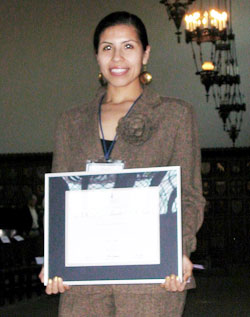 Flor Yunuén “June” García Becerra (ChemE, Enviro)
Flor Yunuén “June” García Becerra (ChemE, Enviro)
BEng, Universidad Iberoamericana (Mexico City), 2001
M. Biotech, University of Toronto Mississauga, 2005
PhD Candidate, University of Toronto
Honours and Awards
- Frances Bradfield Graduate Fellowship in Environmental Engineering, University of Toronto, 2008
- Graduate Scholar (Adel S. Sedra Distinguished Graduate Award Finalist), University of Toronto Alumni Association, 2008
- Water Environment Association of Ontario (WEAO) Scholarship, 2007
- CONACyT Scholarship (Mexican National Advisory Board for Science and Technology) for PhD studies, 2005 - 2009
- CONACyT Scholarship for Master’s studies, 2003 - 2005
Affiliations
- Leader of the Mexico Scoping Study team for Water for People
- President of the U of T Student Chapter of the Water Environment Association of Ontario (WEAO)
- Business Manager of Chemical Engineering Graduate Student Association CEGSA, 2005 - 2007
Describe your research.
My research explores the possibility of harvesting potentially valuable organic compounds from wastewater sludge, with the objective of transforming this waste into useful products, mainly surface active agents (emulsifiers, adhesives). Academic Supervisors: Assistant Professor Edgar J. Acosta (ChemE) and Professor D. Grant Allen (ChemE).
Why did you choose U of T for your Engineering graduate studies?
I chose U of T for my PhD studies because it is one of the best equipped universities in North America to carry out sound scientific research. Also, I am an individual with a passion for Engineering, the environment, and education, and I found that the people at the Faculty of Applied Science and Engineering at U of T have both the talents and the commitment to make substantial progress in these areas.
What are your plans for after graduation?
While I have not decided if I want to pursue a life in academia or industry, what I can say for certain is that I would like to be involved professionally in addressing current environmental challenges facing our global civilization, especially those concerning water and sanitation. I believe today’s environmental and economic crises indicate that our way of life is unsustainable and harmful, and we must produce innovative and holistic solutions if we are to surpass this period of transition. I look forward to today’s challenges and consider it my life’s work to make significant contributions to both society and technology.
BEng, Ryerson University, 2004
MASc, Ryerson Unversity, 2006
PhD Candidate, University of Toronto
Honours and Awards
- Loreal – UNESCO Scholarship for Women in Science
- NSERC CGS-D3
- Anita Borg Google Scholarship Finalist
- Governor Generals’ Gold Medal (MASc)
- Two-time winner of Best TA of the Year Award
Affiliations
- Chair of the IEEE Graduates of the Last Decade (GOLD) Affinity Group – Toronto Section
- Regional Student Representative for IEEE Canada (Student Activities Committee)
Describe your research.
My research concerns medical image processing of cerebral (brain) MRI. Medical image processing is a term that describes software algorithms that automatically analyze digitized medical imagery to extract useful information. For my thesis in particular, I am researching new methods to quantify white matter lesions in the brain (they are neurodegenerative lesions, which reside in the brain’s white matter). As white matter lesions are a precursor of future stroke, understanding earlier stages of the disease can lead to better intervention protocols and therapy strategies. My objective is to come up with novel measures that describe the distribution of these lesions throughout the white matter. This research is being conducted in collaboration with Sunnybrook Hospital (Medical Imaging Research Department). Academic Supervisor: Professor Anastasios Venetsanopoulos (ECE).
Why did you choose U of T for your Engineering graduate studies?
I chose U of T for my graduate studies for several reasons. Firstly, having done my Bachelor's and Master's at another University, I felt that it was important for me to experience a new environment. Additionally, the world renowned professors (including my supervisor) and library resources at the University of Toronto make for a very rich research environment. As a last point, the University of Toronto is known for attracting top students. Overall engagement with these students helps each one of us to grow and learn. This results in a diverse knowledge-base while being inspired by others–these are some of the most important experiences of being a PhD researcher.
What are your plans for after graduation?
After graduation, I wish to pursue leading edge research in biomedical image analysis techniques for MR images of the brain in a university setting, where I may have my own research lab. While researching, I intend to continue to teach Electrical Engineering courses, to promote the Engineering profession and to be a positive role model to young minds, through teaching and mentorship. In addition to my role in academia and mentoring, I wish to have some industrial involvement, by continuing to consult and provide custom signal and image processing software, through Khademi Consulting.
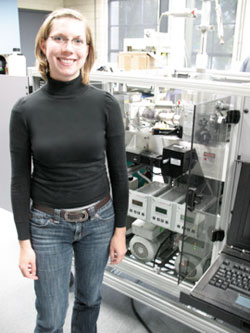 Maygan McGuire (ChemE)
Maygan McGuire (ChemE)
BEng, McMaster University, 2003
PhD Candidate, University of Toronto
Honours and Awards
- Graduate Research Award, U of T’s Centre for Global Change
- Science, 2008
- Junior Fellow, Massey College
Affiliations
- Licensed Professional Engineer in Ontario
- Co-Chair of Engineering Leaders of Tomorrow: Graduate
Describe your research.
I am studying the sources of air pollution in Southern Ontario, particularly focusing on atmospheric particulate matter in Windsor, Ontario.
At any time, the particles in the air form a mixture, which comes from a combination of a variety of different sources. By analyzing the chemical composition of the particles, and knowing the composition of the particles a given source emits, we can use statistical models to “unmix” this mixture and tell us which sources are contributing to poor air quality in that region.
The goal of the research is to assist government agencies to understand the real impacts of different sources (from traffic to coal fired power plants), so that they can make more informed decisions for environmental regulations and policy.
Why did you choose U of T for your Engineering graduate studies?
After graduating from McMaster in 2003, I worked in industry for three and a half years as a Metallurgical Engineer at a company that specialized in forensic analysis and repair of gas turbine components. During that time, I was afforded the opportunity to travel and perform on-site consultations of gas turbines, mainly for the power generation industry. Working in industry also allowed me to realize the importance of my commitment to our environment, so I decided to shift the focus of my career to environmental studies. In the fall of 2006 I made the move to go back to school and pursue a PhD in the Environmental Engineering field.
I chose the University of Toronto because of the opportunity to work in a lab with world-class air pollution research facilities with my supervisor Professor Greg Evans (ChemE) in the Southern Ontario Centre for Atmospheric Aerosol Research (SOCAAR). Not to mention the opportunity to live in Toronto for 4 years—a city that I love—was also an attractive factor.
What are your plans for after graduation?
Following graduation, I hope to work for the government or a not-for profit organization working in environmental policy, more specifically addressing Canada's policies on air pollution emissions and how they relate to air quality and climate change.
BASc, University of Toronto, 2005
PhD Candidate, University of Toronto
Honours and Awards
- UTAA Distinguished Graduate Award, 2008
- Etkin Medal of Excellence, 2007
- Mary H. Beatty Fellowship, 2007
- Canada-EU Student Exchange Scholarship, 2007
- National Sciences and Engineering Research Council of Canada Doctoral Canadian Graduate Scholarship (NSERC CGS-M), 2007-2009
- NSERC CGS-M, 2005-2007
- Canadian Aeronautics and Space Institute Student Award, 2005
- Engineering Science Award of Excellence, 2004
- Team Leader, UTIAS Human-Powered Ornithopter Project
Describe your research.
My graduate research is focused on understanding the complex aerodynamic and structural mechanism that make animal flight so incredibly efficient and applying that knowledge to the design of mechanical flapping-wing aircraft (ornithopters). The core of the work is the development of aerodynamic computer models that can adequately predict the ornithopter's performance and the use of those models in understanding how specific parameters such as flapping frequency, amplitude, or upstroke wing folding interact to produce efficient lift and thrust. The primary application of this research is in the design of small, hummingbird-like, flapping-wing aircraft, that can outperform similarly scaled rotorcraft, but recently my focus has been on applying our knowledge to aircraft of a somewhat larger size.
Recently, as an offshoot of the research being performed in our lab, the Human-Powered Ornithopter project was born. The project aims to accomplish one of the original aeronautical dreams by having a pilot sustain flight in a flapping-wing aircraft using only his/her own raw muscle power. The aircraft, currently under construction at a hanger north of Toronto, has a span of 30 metres and is driven by the rowing motion of the pilot and weighs under 100 pounds. The project is roughly on schedule and is preparing for flight tests in early summer of 2009.
Why did you choose U of T for your Engineering graduate studies?
Beyond the fact that UTIAS is ranked amongst the best aerospace graduate schools worldwide, my choice in coming to U of T was largely based on the supervisor and an intrinsic interest in the unique work that was being performed. Professor James DeLaurier (UTIAS), one of the pioneers of successful flapping-wing flight, started his research on the subject long before it became a trend. His attitudes and research methods are, like his research area, unique and applied at the same time, and it is this combination that makes the lab a very exciting place to work.
What are your plans for after graduation?
I'm currently looking into several post-graduation options, including post-docs in exotic locations, settling down into a job in the Canadian aerospace industry, or developing some of our technologies further in the context of a small aerospace firm. My real dream is to be able to combine my interests in aeronautics and film to develop hovering camera platforms for nature documentaries and outdoor sports cinematography. Alternatively, work in the emerging sustainable energy or sustainable transportation sectors would be incredibly exciting. So obviously no fixed plans yet, but with one year left on my PhD (fingers crossed), I think it's time to start looking ahead.
BASc, University of Toronto, 2006
MASc, University of Toronto, 2008
PhD Candidate, University of Toronto
Honours and Awards
- Alcan Research Fellowship
Affiliations
- Former Fabrication Lead for U of T’s Blue Sky Solar Racing
- Ontario Volunteer Service Award, 2003
Describe your research.
In short, my research is focused on developing a sensor to determine the velocity of liquid aluminum. Improvements to the energy efficiency of electrolytic aluminum (Al) processing operations can be developed once the magnitude and direction of liquid Al within the reactor is known; however, there is no effective means to measure the velocity of a high temperature liquid metal. The aim of my research is to develop a technique to measure the localized velocity in liquid Al, under industrial plant scale conditions. My academic supervisor is Professor Stavros Argyropoulos (MSE).
Why did you choose U of T for your Engineering graduate studies?
I've received my other two degrees here and enjoyed the experience so I didn't see the hype behind going to another institution to study. Plus, I know U of T’s Faculty of Applied Science and Engineering is ranked as one the top ten in the world.
What are your plans for after graduation?
After graduation I plan on working in industry, to experience what my friends who are working have described ot me. In this case, I don't mind moving to another city or country to find work. From what I understand there is a lot of cool research being performed in Europe, I think I will look at work over there as well as in the US and Canada, of course.
Kyle Vernest (IBBME, Clinical)
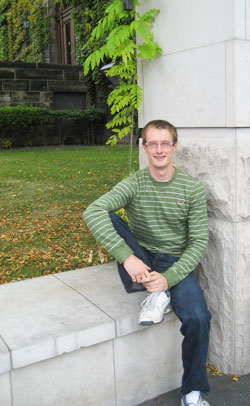
BSc, University of Guelph, 2007
MHSc Candidate, University of Toronto
Honours and Awards
- 1st Prize for presentation at Clinical Engineering Society of Ontario Conference, 2008
- Consulting Engineers of Ontario Merit Award, 2006
Affiliations
- Member of the U of T Varsity Rowing Team (2007 and 2008)
- Member of the Triggerfish Water Polo Team
Describe your research.
There is currently a disconnect between bone density measurements from Dual Energy X-ray Absorptiometry and bone strength as some patients who have good bone density still fracture. As such, we are designing a new device to measure bone strength non-invasively through vibrating the ulna or tibia for use in the monitoring and detection of Osteoporosis, a disease that affects one in four women over the age of 50. Academic Supervisor: Dr. Angela Cheung (Faculty of Medicine).
Why did you choose U of T for your Engineering graduate studies?
It was a pretty easy choice! U of T is known internationally as an outstanding Engineering school and the Clinical Engineering Program (MHSc) at IBBME was the first of its kind in Canada, and continues to be the leading program in North America. Additionally, the MHSc program has a unique blend of contemporary courses, a thesis research project and clinical internships, either in university teaching hospitals and/or in the medical device industry.
What are your plans for after graduation?
After graduation I am planning on continuing my studies at U of T, pursuing a PhD in Biomedical Engineering at IBBME. I am planning on furthering our research on the new medical device we are developing at Toronto General Hospital.
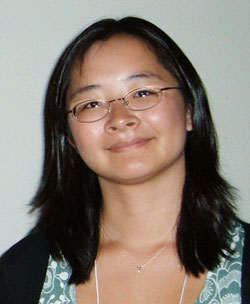 Lorna Wong (MIE)
Lorna Wong (MIE)
Hon BSc, University of Toronto, 2003
MEng, University of Toronto, 2007
PhD Candidate, University of Toronto
Affiliations
- Co-president of Association of Mechanical & Industrial Graduate Students (AMIGAS)
- Led AMIGAS in organizing social, professional, and leadership development events
Describe your research.
My research is in the area of maintenance optimization for repairable systems, a specialized branch of operations research. I am working on developing a model for expensive and complex systems that are subject to repair and condition monitoring. Repair and condition monitoring information can be used to develop a statistical model to provide an assessment of the system's health and predict its remaining useful life. Our group has an industry consortium consisting of 12 Canadian and international organizations—we work closely with these companies to ensure our research is practical and applicable to real-life problems. Academic Supervisor: Professor Andrew K.S. Jardine (MIE).
Why did you choose U of T for your Engineering graduate studies?
MEng: I first became interested in Industrial Engineering when I began working as the Graduate Program Assistant in MIE. I did mathematics in my undergrad and became interested in some of the graduate courses offered in MIE. My work supervisor suggested that I take those courses as part of the MEng program part-time while working. I realized that a Master's degree in Engineering from U of T would broaden my skills, and help me find a job in a field I hadn't previously considered.
PhD: As part of my Master's, I decided to do a research project in the Centre for Maintenance Optimization and Reliability Engineering as I knew this would also help me making connections in finding an Engineering position; however, at the end of the project, Professor Jardine offered me a position as a PhD student. I carefully looked over all the options and basically came to the conclusion that the best path was:
- A PhD from a top-ranking university (both in Canada and internationally).
- A unique research opportunity for extensive industry involvement and collaboration.
- An excellent professor who is well renowned in his field.
- A wide variety of possible career paths following from all of the above.
I'm not totally sure what my plans are—they've changed since I finished my Master's and started my PhD. I thought I would just get a job in the industry (Maintenance Engineering) after graduating from the MEng program; however, as I've started my PhD, I've become more aware and open to the opportunities that will be available after my PhD. These include working in the Maintenance Engineering industry and teaching (both with or without research). I'm still leaning towards a job in the industry, but as my PhD progresses, I may change my mind.
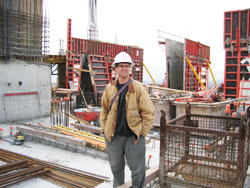
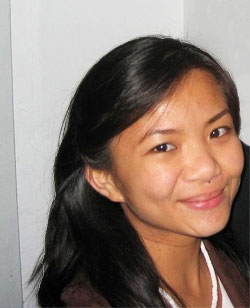
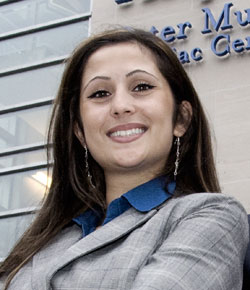
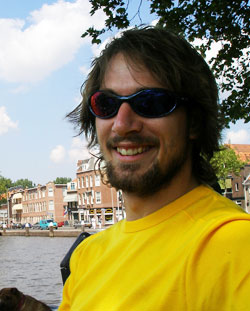 Todd Reichert (UTIAS)
Todd Reichert (UTIAS)